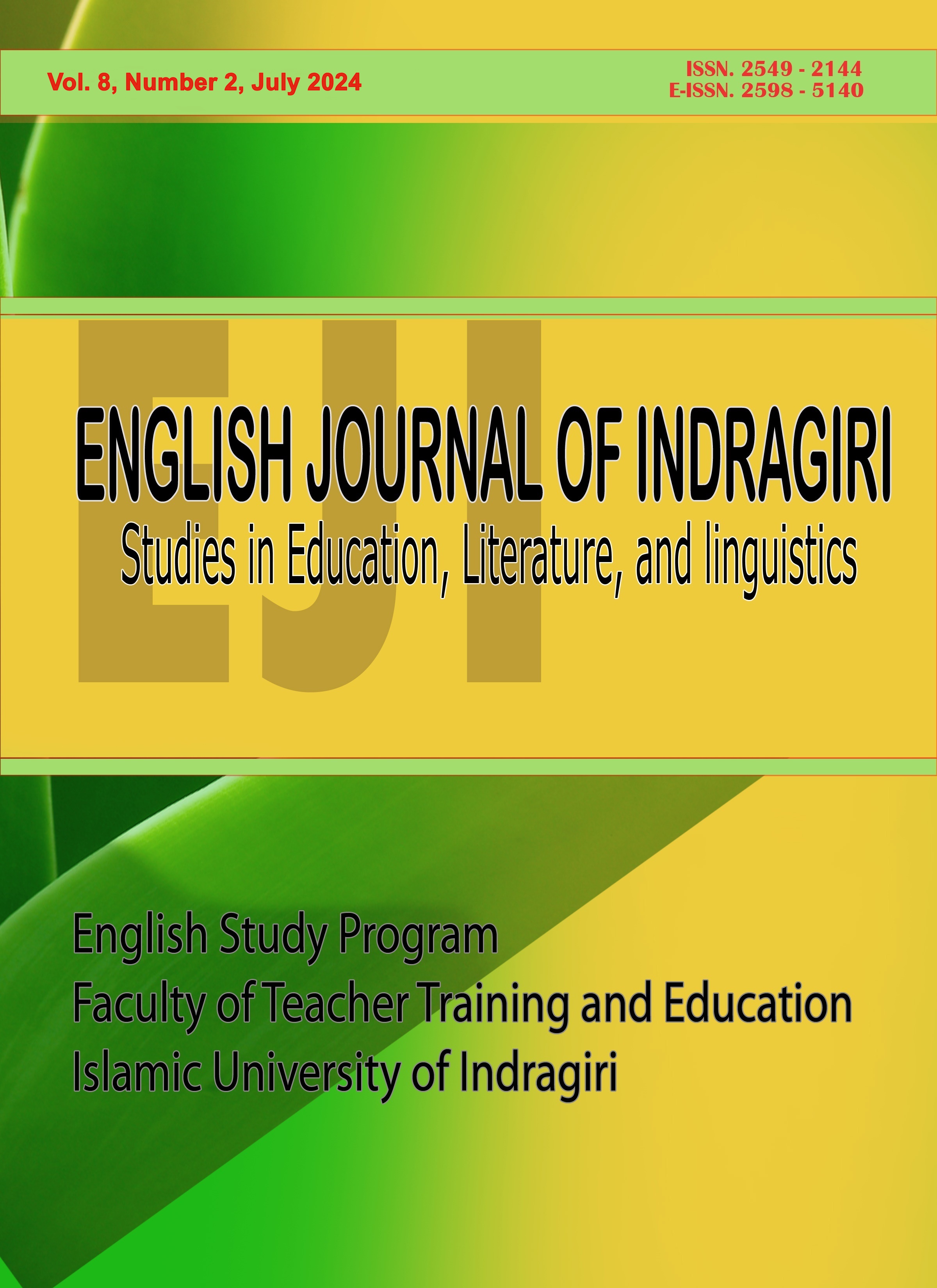The Role of Technology in Teaching Ending Sound –s/-es Pronunciation: EFL Perception
DOI:
https://doi.org/10.61672/eji.v8i2.2775Keywords:
Technology;, Ending sounds, PronunciationAbstract
Pronunciation has been regarded as the most challenging aspect of language teaching and learning. EFL learners faced difficulties in perceiving, producing, and mastering the intricate sound patterns of a new language, which can lead to communication breakdowns and reduced intelligibility. The use of learners-made tutorial videos in teaching pronunciation might overcome some of these challenges. This research aimed to find out learners’ perception of the role of technology in teaching ending sounds –s/es pronunciation through learners' self-made tutorial video. The research used descriptive qualitative method. The sample was taken by purposive sampling technique. Ten learners from the first semester of 2023/2024 academic year from a private public college in Pekanbaru were taken as the sample. The instrument used to collect data was questionaire from google form. The data were analyzed by using three data analysis theories. After analyzing the data, it was found that technology helped learners to be more responsible in studying, gain more knowledge beyond what the lecturer taught in the class, learn independently, encourage them to exchange knowledge with their classmate, and improve their English skill through making self tutorial videos in pronouncing –s/-es ending sound. Thus, it can be concluded that learners had a positive perception on the role of technology in teaching pronunciation especially in pronouncing –s/-es ending sound. Regarding the positive perception on the role of technology in teaching ending sound –s/-es perception, it is suggested to lecturers as well as English teachers to optimize the role of technology in teaching not only ending sound –s/-es, but also other aspects of pronunciation.
References
Akbarov, A., Gonen, K., & Aydogan, H. (2022). An investigation into EFL learners’ perceptions of learner-generated videos and willingness to communicate. Computer Assisted Language Learning, 35(3), 419–445.
Alkhasawneh, R. (2021). Using technology for learning English as a foreign language in Saudi Arabia: Effects on student motivation and attitudes. English Language Teaching, 14(9), 81–93.
Baran-Łucarz, M. (2014). The link between pronunciation anxiety and willingness to communicate in the foreign-language classroom: The Polish context. Canadian Modern Language Review, 90(4), 445-473.
Cresswell, J. W. (2014). Concise Introduction of Mixed Methods research. In Sage Publication. Sage Publication.
Derwing, T. M., & Munro, M. J. (2015). Pronunciation fundamentals: Evidence-based perspectives for L2 teaching and research. John Benjamins Publishing Company.
Dörnyei, Z., & Ryan, S. (2015). The psychology of the language learner revisited. Routledge.
Foote, J. A., Holtby, A. K., & Derwing, T. M. (2016). Pronunciation instruction for adult learners of English. The Language Learning Journal, 44(2), 181–196.
Hafner, C. A., & Miller, L. (2019). English students’ experience of individual YouTube video project assignments across samples of different academic levels. TESL-EJ, 22(4), 1–21.
Hamid, M. S., Sussex, R., & Khan, A. (2022). Language learners’ technological self-efficacy and attitudes toward mobile-assisted language learning. System, 106.
Henderson, M., Selwyn, N., & Aston, R. (2017). What works and why? Student perceptions of “useful” digital technology in university teaching and learning. Studies in Higher Education, 42(8), 1567–1579.
Hung, S. T. A., & Huang, H. T. D. (2015). Video project in the profound instruction for the learners. Asian EFL Journal, 89, 73–93.
Ismailia, T., & Binarkaheni, S. (2022). The impact of student-created video projects on English language skills. Journal of English in Academic and Professional Communication, 8(1), 10–20.
Jewitt, C. (2022). The Routledge Handbook of Multimodal Analysis (3rd ed.). Routledge.
Jiang, A. (2023). The effects of vlogging on ESP learners’ motivation and comprehension. British Journal of Educational Technology, 42(5), 736–746.
Little, D. (2022). Language learner autonomy: Rethinking language teaching. Language Teaching, 55(1), 82–96.
Maspufah, Fathira, V., Zuriati, D., Asril, L. Z., Afriyeni, Y., & Masbiran, G. (2023). Putting Pronunciation into Practice. Hawa and Ahwa.
Mayer, R. E. (2021). Multimedia learning (3rd ed.). Cambridge University Press.
Mehring, J. (2016). Present research on the flipped classroom and potential tools for the EFL classroom. Computers in the Schools, 33(1), 1–10.
Miles, Matthew B, Huberman, A, Michael and Saldana, J. (2014). Qualitative Data Analysis: A Method Source Book. In Sage Publication Inc (Third Edit). Sage Publication.
Niemi, H., & Multisilta, J. (2016). Digital storytelling promoting twenty-first century skills and student engagement. Technology, Pedagogy and Education, 25(4), 451–468.
Nikitina, L. (2011). Creating an authentic learning experience in Russian language classrooms. ACTR Letter, 20(4), 1–11.
Pardo, A., Mirriahi, N., Diamantidis, D., & Gasevic, D. (2023). Continuous learning design for learners’ experiences with video resources. Computers & Education, 193(104724).
Ryan, S. (2013). Video-aided lesson observation and teacher development: Teaching captioning for multimedia comprehension. CMLR, 62–82.
Sunderland, J., & Alani, H. (2021). Using digital content created by students: IP and privacy concerns, and the role of consent. Journal of Further and Higher Education, 45(4), 539–557.
Yin, L. K., & Lam, H. C. (2020). Mandarin video project: A tool for fostering autonomous learning. Jurnal Pendidikan Bahasa Melayu, 10(2), 11–22.
Downloads
Published
Issue
Section
License
Copyright (c) 2024 Maspufah, Yeni Afriyeni, Jumerli Ariati, Diana Zuriati

This work is licensed under a Creative Commons Attribution 4.0 International License.




















